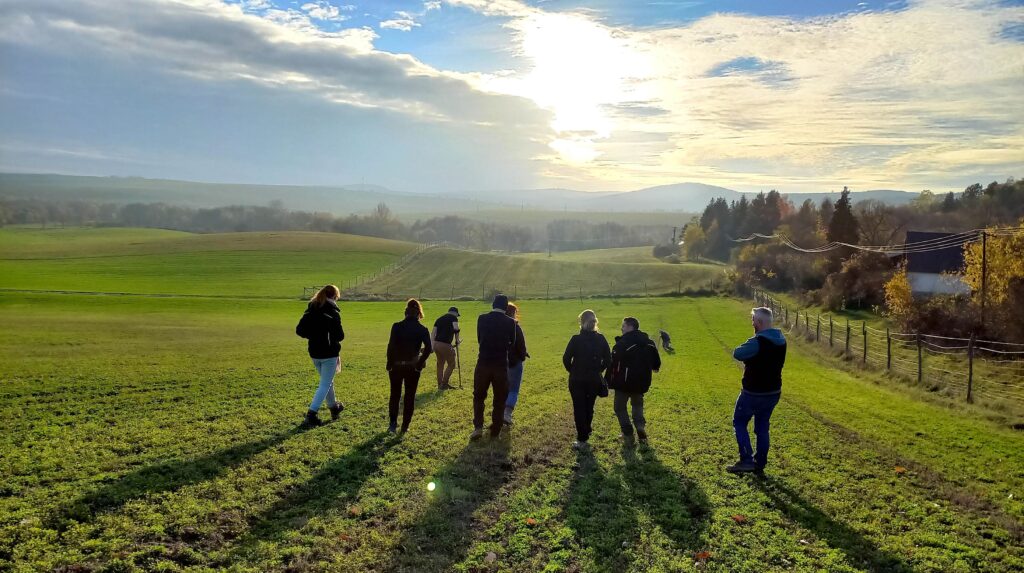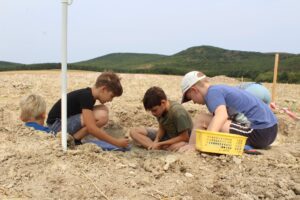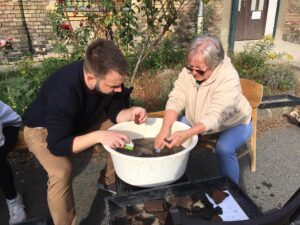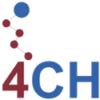Introduction
In March of 2022, a temporary exhibition was opened in Budapest, presenting the results of the Public Archaeology Programme of the Hungarian National Museum (HNM). The exhibition, entitled ‘A Treasured Community’ is a tribute to the volunteers involved in the institution’s programme, which started as an experiment back in 2017. The Hungarian National Museum owes much to this community for artefacts that would never have been found without their help. The group has now about 500 members of all different ages and professions from all over the country, who share similar interests in protecting our cultural heritage.
Ways of volunteering

Field survey organised by the HNM in 2022 with volunteer detectorists
The prestige of volunteering in a cultural institution, especially in a museum, has been proven for some time now by several surveys among the participants. The most important advantage of volunteering is getting a behind-the-scenes look at several different aspects of the museum work, together with people with similar interests. Activities like this are extremely popular among people from totally different professions, such as engineers or policemen, who want to do something a little different from everyday tasks. Archaeology is particularly suitable for this purpose, mainly because almost everyone has dreamed of becoming an archaeologist as a child, and through this programme, a part of this dream can come true.
In the programme, the museum attempts to give tasks that suits everyone’s own interests. Participants will be given an insight into the phases of the complex research of an archaeological site, from the field activities to the scientific research of the finds. During field programmes, volunteers can participate in field surveys with the aim of detecting new archaeological sites (collecting finds e.g. pieces of ceramic vessels, metal objects, stone fragments etc.). Metal detecting is strictly regulated in Hungary, which means that detectorists can only use their instrument during field surveys organised by an archaeological institution. Solitary metal detecting, namely without an archaeologist, is not allowed.

Children on site at the 2022 excavation organised by the HNM
Summer excavation camps are extremely popular with families: children particularly enjoy every phase of excavating. This type of programme is based on excavating and saving unknown medieval cemeteries disturbed by ploughing activities. Local people often inform the museum about a possible archaeological site where they see scattered finds on the ground. If possible, the museum starts to get ready for the excavation with the help of volunteers through collecting historical and topographical data about the site and talking with local responsible persons. Two such projects were already organised in the last few years in Nógrád County, where 200 people joined to rescue a small but precious part of the cultural heritage. It was a very interesting and heart-warming experience for the archaeologists that not only local people came to participate, but families living more than 50 kilometres away had the time and interest to join. The participants were enthusiastic about finding something that was a part of their past. Everyone was happy for each other’s success, and at the end of the day, all the finds were presented to the participants, which they found very exciting.
The museum work does not stop at field surveys: volunteers can contribute to the historical research or analysis of the finds as well. People are also interested in the post-production work such as washing finds, writing descriptions, making drawings and maps, which help them improve their knowledge about the archaeological material as well as contributing to documentation archives.
Visible results on display
The aforementioned exhibition presents 24 groups of artefacts that, with one or two exceptions, have never been seen before. Among the most important finds are the gold artefacts from the Hun sacrificial finds at Nyergesújfalu, which include buckles and various mounts. In addition to the rich artefacts from the Árpádian Age (10-11th century) cemetery at Kisbárkány, Nógrád County, the exhibition also includes finds from several graves. The smallest object is barely one square centimetre, the largest is a Roman milestone weighing more than 70 kilograms.

Washing finds from the 2022 excavation
Volunteers participating in the public archaeology programme do particularly important work useful for both them and the community. New friendships have been formed since, and the ‘old’ volunteers have started to educate the ‘new’ ones once on site. A specific focus is on the involvement and education of children because the future of the Hungarian archaeology mainly depends on them. Even though children see volunteering as a game, they are making a big contribution to saving their past.
Among the long-term plans of the programme, systematic research of larger historical regions is also included such as battlefields, marketplaces, or Medieval church topography. In addition to the field work, they plan to launch a workshop for volunteers to learn the different stages of the work. Preparations are currently ongoing.
Conclusion
Until recently, public archaeology only meant metal detecting in Hungary. In the last few years, the Hungarian National Museum has started to add more and more possibilities for the volunteers joining the programme. People can participate in all phases of the complex research of an archaeological site from the field activities to the scientific research of the finds. Children learn by playing, while helping the professionals and each other discover their cultural heritage and hopefully, will continue to be involved in their future lives.
